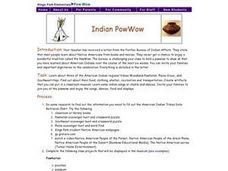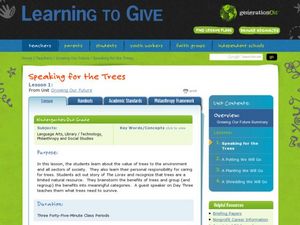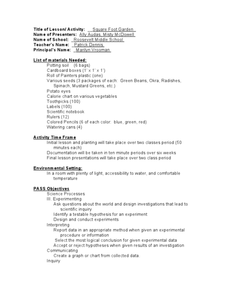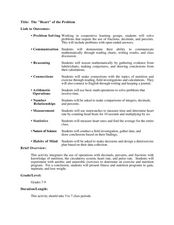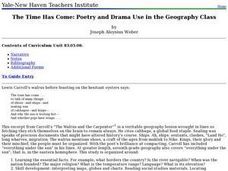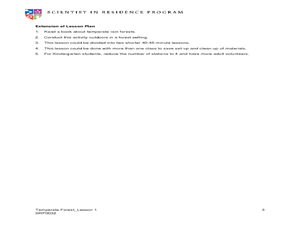Curated OER
Indian PowWow
Students identify three different American Indian regions and tribes, their food, clothing, shelter, recreation, and transportation. Students create artifacts that can be placed in a museum. Students sing songs, chants, and dance. ...
Curated OER
Worms: Nature's Recyclers
Students explore vermi-composting. In this vermi-composting lesson, students listen to the story Diary of a Worm and discuss the parts of a worm. They create worm bins and add organic food for the worms to recycle.
Curated OER
Working Together to Solve a Problem
Students create a food and clothing drive at their school. In this philanthropy instructional activity, students listen to the story Selavi, That is Life, to help them understand homelessness. Then, students brainstorm ways to implement...
Curated OER
Parts of the Plants
Second graders discuss as a class what they know about plants viewing several pictures of plants as well as a tree poster. They work in groups to observe a flowering plant which is removed from a pot with the soil brushed away and is...
Curated OER
How Does Your Garden Grow?
Young scholars read The Garden by Arnold Lobel, plant seeds to discover what makes them grow, and record their observations in their journals.
Curated OER
A Potting We Will Go
Young scholars read A Tree is Nice and It Could Still Be a Tree. In this tree planting lesson plan, students compare and contrast private property and common resources. Young scholars identify the needs of a tree and follow the...
Curated OER
Eagle Boy: A Pacific Northwest Native Tale
Students read the story of the Eagle Boy. For this Native American Tale lesson, students discover the respect a boy has for wildlife. Students discuss eagles and what they symbolize. Students create song lyrics for the story and...
Curated OER
Speaking for the Trees
Students present a play based on The Lorax.For this environmental issues lesson, students read and discuss literature and complete activities pertaining to environmental stewardship.
Curated OER
What Does The Heart Do?
Students study the relationship between the heart and circulation. In this circulatory system lesson, students read the "What Am I?" article about the heart and discuss. Students draw a heart and lungs, discover how blood is pumped...
Curated OER
Square Foot Garden
Students plant a garden and keep track of it. In this geometrical garden lesson, students collect data from their garden twice a week. They graph their finding and figure out how many square feet of growing space each person needs...
Curated OER
The "Heart" of the Problem
Students create an exercise and nutrition program. In this interdisciplinary lesson, students use calculations of exercises plus their corresponding effects on the body and nutritional values of food to derive a health plan. Students...
Curated OER
The Time Has Come: Poetry and Drama Use in the Geography Class
Middle schoolers use drama and poetry in their Geography class. In groups, they role play an interviewer or the interviewee in various plays that were presented to them. In their role, they must locate and label where the countries...
Curated OER
Action and Linking Verbs
In this recognizing action verbs and linking verbs in sentences worksheet, students read statements, identify the verbs, and label them either action or linking verbs. Students write 15 answers.
Curated OER
High Five Burger
Fifth graders investigate agricultural sources. In this agricultural instructional activity, 5th graders read the book Have a Hamburger and See the U.S.A. and record each component of a hamburger. Students use a map of the U.S.A. to...
Curated OER
An Egg is Quiet
Students discover information about animal eggs by reading the book, An Egg is Quiet. In this animal science lesson, students research different animals to find out what their eggs look like. Students use a provided chart to...
Curated OER
Exploring Forest Objects
Students explore the forest. In this ecosystems lesson, students rotate through sensory activity centers, brainstorm, and read about temperate forests.
Curated OER
No Title
First graders listen as the book, "Tops and Bottoms," by Janet Stevens is read to them and then participate in a discussion about foods and where they grow. They draw a picture of a plant labeling the major parts of it sequential order.
Curated OER
Children's Literature Across the Curriculum Ideas: The Magic School Bus Plants Seeds
Students read The Magic School Bus Plants Seeds by Janna Cole. They complete a variety of cross-curricular activities surrounding the study of plants and seeds. Included are reading, art, math, science, writing, social studies, and...
Curated OER
Yo! Gert-making yogurt
Young scientists or chefs culture yeast to produce yogurt. The materials and a general description of how make yogurt are provided, but there is very little detail otherwise. You could use this as an activity when your biology class is...
Curated OER
Pour Some
Students compare their desired portions with the actual serving size. In this lesson on serving size, students compare their desired portion of a given food with the actual serving size listed on the Nutritional Facts label.
Curated OER
Phonemic Awareness: Pronunciation of /ng/ Consonants
Students practice cononant sounds within reading passages. They articulate the /ng/ sounds and identify their placement in words. Working with a partner, they read a passage aloud and listen for correct pronunciation of sounds.
Curated OER
Science
Young scholars read labels of candy bars. In this ingredients instructional activity, students examine a variety of candy bar labels to determine the contents. Young scholars research to find additional information on each candy...
Curated OER
Starvation in the Ghettos
Learners consider the lack of nutrition experienced in Holocaust ghettos. In this Holocaust lesson, students investigate the Nazi policy of starving people out of the ghettos through their food rationing program. Learners compare Nazi...
Curated OER
Sunny or Shady?
Pupils practice answering questions to aid in creating meaning when reading. Through guided practice, they read a passage from the chapter book "Tuck Everlasting" and answer in-text and inference questions. Independently, they read...
